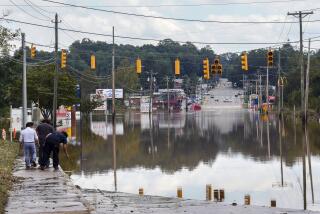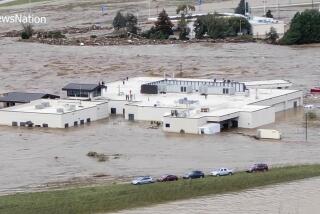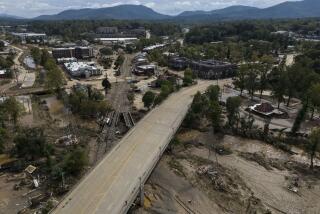Flood Puts Town in Rebuild Mode
NORTHFORK, W.Va. — For the second time in 10 months, residents of the Appalachian coal towns along the Tug Fork river were digging out from a devastating flood Saturday and talking about rebuilding their lives and homes and businesses.
“We’re tough people up here in the mountains, but we’re getting tired of this,” said Marvin Cochran, 45. “I’ll put things back together again because this has always been home. But my father says he’s getting out, if we can get his trailer off the hill.”
Near an emergency center where Cochran had come for bottled water, the river still gurgled with high, muddy water. “At least it’s started going down,” he said. Then he looked at the heavy dark clouds overhead and added, “Those clouds let loose and she’ll come right back up.”
Tug Fork, which separates West Virginia and Kentucky, crested Friday at nearly 20 feet above flood stage after a night of heavy rain. The overflow rushed through the little towns stretched out along Route 52--just as had happened last July--and left in its wake a sense of weariness among people who for generations have entrusted their fate to God, nature and the coal companies.
“You really admire the resilience of people like this,” said Capt. Sandra Mullins of the Salvation Army as she handed out ham salad sandwiches. “But you look in their faces and you see the sadness and the tiredness. They were just recovering from the last flood.”
After the last one, the state began investigating whether new coal mining practices were to blame for the intensity of the flooding. In the last 10 years, coal companies have been shearing off mountaintops to get to coal and piling the leftover rock and dirt into valleys, forever altering the region’s topography.
Officials said this flood, which also touched part of Virginia and Kentucky, killed at least five people. Rescue crews were searching door to door for a dozen missing.
Many of the towns, like Northfork (population 591), were temporarily isolated when landslides cut Route 52. By Saturday, crews with bulldozers and shovels had reopened the road. The National Guard was helping with the cleanup and search operations.
“I’d taken time off and spent three months repairing my mother’s home after the last flood,” said Mike Boyd, 38. “Now this. Her home is a wreck. ... Even my late father’s ’88 Cadillac was swept away. I can’t take time off again.”
On Northfork’s main street--littered with plastic bags, tree limbs and debris carried by the flood--the town’s funeral director, Mike Widener, had installed a steel door after the last flood to protect a display of 25 caskets in his basement. The contractor had guaranteed not a drop of water would get in.
The steel door splintered Friday and the caskets were destroyed.
Widener’s recently remodeled ground floor office was spared, and Saturday, as though unsure what to do next, Widener was cleaning his desk with a feather duster.
“We lost everything the first time ... But I’ll start over. Of course, I will. In Appalachia, it seems we’re always doing that.”
That’s what people tried to do when the coal companies pulled back from these towns in the 1970s. The scars are evident: empty store fronts, hotels turned into residences for the elderly, abandoned car dealerships, the faded words “Montgomery Ward” on the side of a building.
Sometimes, though, there is a sound that harks back to more prosperous times. It came Saturday, just as Widener was dusting --a lonely wail that reaches up the hollows, then the rumble of Northfork Southern Railroad engines, snaking out of the mountains, bound for Roanoke, Va., with a mile-long procession of loaded coal cars.
It is a reminder that life goes on.
More to Read
Sign up for Essential California
The most important California stories and recommendations in your inbox every morning.
You may occasionally receive promotional content from the Los Angeles Times.










